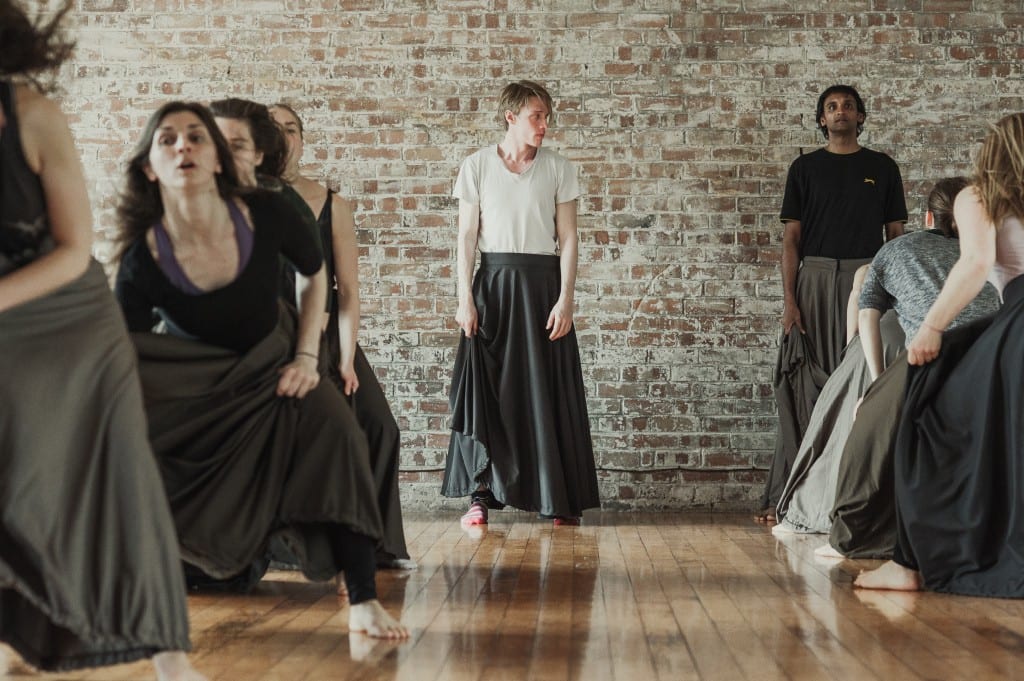4
Reviewer's Rating
Performed in a church in Shoreditch, with the audience sitting on pews only feet from the actors, this is an innovative and intimate exploration of Hamlet, Shakespeare, and theatre. The show is called ‘Studying Hamlet’ for a reason: it is not ‘Hamlet’, and we’re not supposed to think it is. Instead, this is an attempt to interrogate the text and explore the motivations and emotions of these famous characters, in the hope of understanding something new.
Backed by a polyphony of Iranian lullabies, the actors move illogically from scene to scene, trying again and again to pinpoint the right approach. There are few props used in this performance: the actors wear long skirts, which double up as capes, shrouds, and skulls, and there are a few musical instruments and wooden sticks. Mostly, though, this is a stripped-back performance, allowing us as the audience to fill as many gaps as possible with our own interpretations. The music is all performed onstage, as the actors play their instruments or vocalise – the church’s acoustics mean that the dialogue is sometimes hard to hear over the music, but this is not necessary to understand the play, which is, after all, about madness and chaos. The proximity of the actors and audience make for an intimate performance – we are drawn in, despite ourselves, close enough to see the scratches on Hamlet’s back and the sweat on his arms. The show is exhilarating, as we are caught up in the chaos of this illogical and frenzied production, and try with the actors to understand what is happening in a scene.
‘Hamlet’ is dissected and performed disjointedly, with many important scenes missing – most notably the finale. The scenes which are performed are some of the play’s best-known: Ophelia’s final speech, Hamlet’s “to be or not to be” soliloquy, and the graveyard scene. Both Ophelia’s final speech and Hamlet’s soliloquy are performed multiple times, by different actors, as each actor tries to find something in the role that they relate to. Shakespeare’s dialogue is spliced with other, more modern stories – which are recounted in a variety of languages – in an attempt to show the universality of Shakespeare and his stories. This is an overtly feminist production – the women outnumber the men significantly, and the male roles have been reduced: there is Hamlet, of course, and a gravedigger, and a few more characters who hover in the background, but never really take centre stage. This marginalisation of Claudius in particular is interesting, and increases the threat he represents – ever-present in his absence, constantly in our minds and the minds of the characters, but never seen. This reduction of the male parts also allows for a deeper exploration of women’s roles, in ‘Hamlet’ and Shakespeare and life. One of the most poignant moments of the performance occurs when one actress says of Ophelia, “to be or not to be… that is not her question.”
Logistically, there are a few flaws to this production: it is sometimes difficult to tell which scene we are in, as the actors are constantly changing and there are no indicators other than the script – even for viewers who know the play well, this is an incredibly complex and confusing performance. Some of the scenes are difficult to follow or understand, and it is dubious whether they bring anything to the production. On the whole, however, the performance achieves what it sets out to do: examine Shakespeare. It asks us how and why we are still reading and performing his plays, discovering new ways to understand and appreciate him, and proves once again that, regardless of age, ethnicity, background, gender or language, Shakespeare is for everyone.

